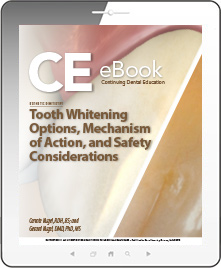Tooth Whitening Options, Mechanism of Action, and Safety Considerations
Released: Monday, November 26, 2018
Expires: Monday, May 31, 2021
By Connie Kugel, RDH, BS, and Gerard Kugel, DMD, PhD, MS
Commercial Supporter: Philips Oral Healthcare
Tooth whitening is one of the most popular dental procedures, and yet it is still poorly understood. This article will review the most common tooth-whitening options. Over the last 15 years there has been an effort to find ways to accelerate and improve the delivery of the whitening process. Clinical cases will be shown to demonstrate the effectiveness of light-activated whitening alone and in combination with enamel microabrasion. Additionally, adverse events and possible side effects will be examined. Tooth whitening has become commonplace in most dental practices, and dentists have many options for treatment. Dentists should evaluate which of these options is best for their patients by taking into consideration their patients’ costs, time constraints, and restorative needs.
LEARNING OBJECTIVES:
-
Describe the tooth-whitening mechanism-of-action theory.
-
Discuss the combination treatment of microabrasion and tooth whitening.
-
List the types of whitening systems available.
About the Author
Connie Kugel, RDH, BS, Boston Center for Dental Education, Boston, Massachusetts, and Gerard Kugel, DMD, PhD, MS, Trinity Dental Practice & Boston Center for Dental Education, Boston, Massachusetts
